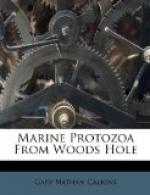Movement consists in rapid swimming, with rotation on its axis, or in creeping by means of its anterior cirri, or in sudden jumping, by which it apparently clears a distance of 20 times its diameter in one bound. Mouth parts may also be used for attachment to foreign bodies. The moving periods alternate with quiescent periods, during which the organisms with their outstretched and radiating cirri resemble the heliozooen Actinophrys.
Mesodinium cinctum, n. sp. Fig. 31.
Body spherical to pyriform, constricted near the middle, the constriction dividing the body into dissimilar parts. The anterior part is broadly pyriform, somewhat plastic and hyaline, with an oral extremity which is sometimes hollow, sometimes evaginated and convex. Upon this flexible anterior part there are four short but distensible tentacles. The posterior part is granular and usually filled with food particles; it is well rounded and holds the nucleus and contractile vacuole. The entire body is surrounded by a fine cuticle. The nucleus is elongate and extends through the greater part of the posterior half. The contractile vacuole lies on one side, near the girdle. The mouth is on the anterior pole in the tentacle region. The motile organs are cirri and cilia, all inserted in the constriction. There are two sets of cirri and one of cilia; the latter stand out radially from the girdle and are usually in motion. The cirri of one set, the anterior, extend forward about twice the length of the anterior half; those of the posterior set closely engirdle the lower half, reaching not quite to the posterior extremity. These are somewhat hyaline and are closely approximated, giving the impression of a tight-fitting crenulate casing about the lower half. The cirri are sharply pointed, much broader at the base, and the two sets are so placed that, looked at from above, they have the appearance of a twisted cord. (Fig. 31 b.) Movement erratic; sometimes the animal swims steadily forward with mouth in front; again it shoots across the field of the microscope, either backward or forward or sideways, through the action of its powerful cirri. It is often quiet, usually mouth downward, and is held in place by adhesion of the tentacles. In this position it looks strikingly like a heliozooen.
Length 35 mu; greatest width 30 mu. Not uncommon.
The chief features by which this species is distinguished from the frequently described M. pulex of Europe are the number of anterior cirri and the ring of true cilia in place of the central girdle of cirri. The European form is described with four anterior bristles; the present form has from 28 to 32. The radial cilia differ decidedly from the more powerful cirri and they are not in one plane, so that counting is difficult; they are not closely set. The presence of tentacles makes these forms of especial theoretical interest, especially in the light of the origin of Suctoria.




